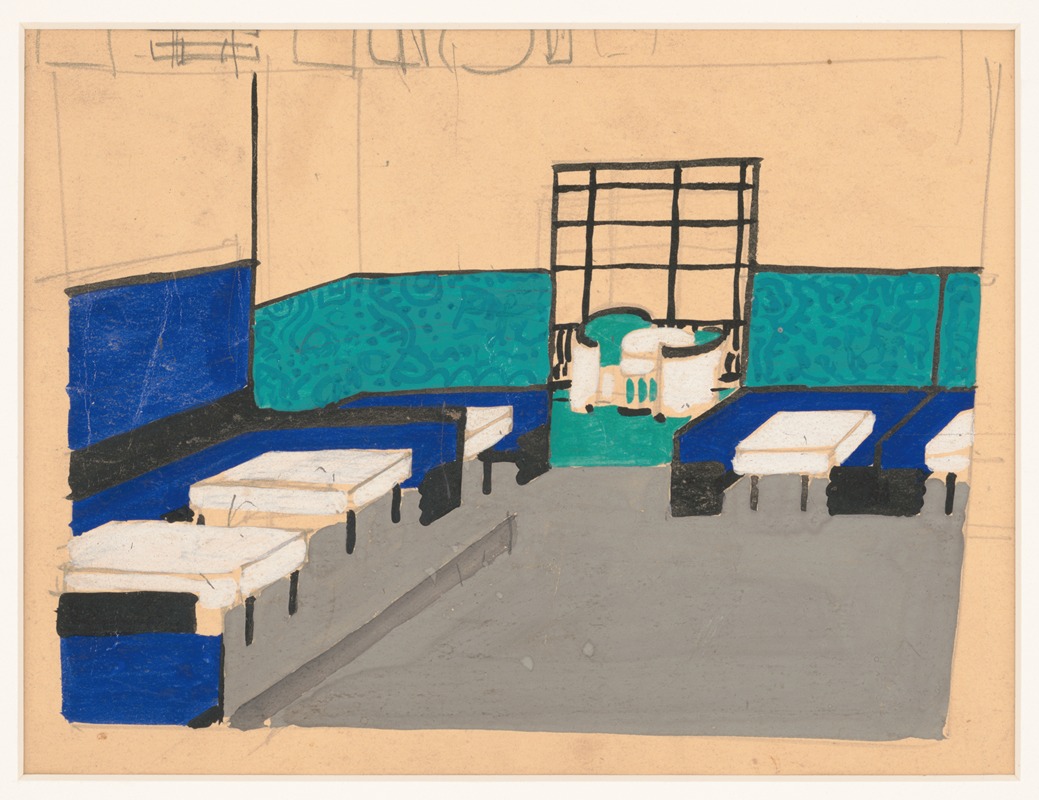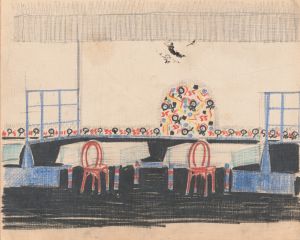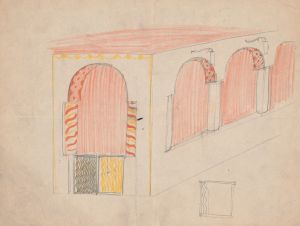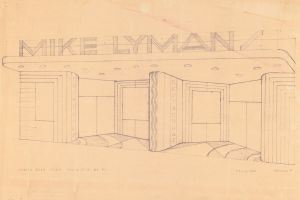
Interior perspective studies for Restaurant Crillon, 15 East 48th Street, New York, NY.] [Study for Batik Room or Main Dining Room
A hand-painted replica of Winold Reiss’s masterpiece Interior perspective studies for Restaurant Crillon, 15 East 48th Street, New York, NY.] [Study for Batik Room or Main Dining Room, meticulously crafted by professional artists to capture the true essence of the original. Each piece is created with museum-quality canvas and rare mineral pigments, carefully painted by experienced artists with delicate brushstrokes and rich, layered colors to perfectly recreate the texture of the original artwork. Unlike machine-printed reproductions, this hand-painted version brings the painting to life, infused with the artist’s emotions and skill in every stroke. Whether for personal collection or home decoration, it instantly elevates the artistic atmosphere of any space.
Winold Reiss was a German-American artist and designer known for his work in interior design and his vibrant use of color and pattern. One of his notable projects was the interior design for the Restaurant Crillon, located at 15 East 48th Street in New York City. Among his contributions to this project were the interior perspective studies for the restaurant's Batik Room or Main Dining Room.
Reiss was born in Germany in 1886 and immigrated to the United States in 1913. He brought with him a European sensibility and a keen interest in integrating art with architecture. His work often reflected a blend of modernist and traditional elements, and he was particularly known for his use of color and pattern, which was influenced by his studies in Munich and his exposure to various art movements.
The Restaurant Crillon project was one of Reiss's significant contributions to the New York City design scene. The Batik Room, or Main Dining Room, was a testament to his ability to create immersive environments that combined artistic flair with functional design. Reiss's studies for this room likely included detailed sketches and plans that outlined the layout, color schemes, and decorative elements that would define the space.
Reiss's design for the Batik Room would have incorporated his signature style, which often included bold colors, intricate patterns, and a harmonious blend of different cultural influences. His work was characterized by a meticulous attention to detail and a commitment to creating spaces that were both aesthetically pleasing and conducive to their intended use.
The interior perspective studies for the Restaurant Crillon would have been an essential part of the design process, allowing Reiss to visualize and refine his ideas before their implementation. These studies would have served as a blueprint for the final design, guiding the execution of the project and ensuring that the finished space met Reiss's artistic and functional standards.
Winold Reiss's work on the Restaurant Crillon is an example of his broader impact on American interior design during the early 20th century. His ability to blend artistic expression with practical design solutions made him a sought-after designer for commercial and public spaces. His contributions to the field continue to be recognized for their innovation and enduring aesthetic appeal.
Overall, Winold Reiss's interior perspective studies for the Restaurant Crillon's Batik Room or Main Dining Room exemplify his approach to design, which was characterized by a fusion of art and architecture, a vibrant use of color, and a dedication to creating spaces that were both beautiful and functional.





![Designs for Hess Brothers Restaurant, Allentown, PA.] [Dinner menu](/imgs/249243/s/winold-reiss-designs-for-hess-brothers-restaurant-allentown-pa-dinner-menu-2d87eef3.jpg)
![Design for unidentified restaurant interior in blue and vermillion with mural featuring 2 female nudes and panel with tulip inserts.] [Drawing for ‘Dining Room’](/imgs/249301/s/winold-reiss-design-for-unidentified-restaurant-interior-in-blue-and-vermillion-with-mural-featuring-2-female-nudes-and-panel-with-tulip-inserts-drawing-for-dining-room-880480c5.jpg)
![Designs for theater with black-framed proscenium and boldly colored settings.] [Study for stage light wall decoration, Caf ̌Crillon](/imgs/249331/s/winold-reiss-designs-for-theater-with-blackframed-proscenium-and-boldly-colored-settings-study-for-stage-light-wall-decoration-caf-crillon-27adcd0f.jpg)
![Designs for unidentified restaurant interior, possibly Elysée restaurant, 1 East 56th St., New York, NY.] [Drawing of restaurant interior elevations](/imgs/249334/s/winold-reiss-designs-for-unidentified-restaurant-interior-possibly-elysee-restaurant-1-east-56th-st-new-york-ny-drawing-of-restaurant-interior-elevations-192740b5.jpg)
![Exhibit design with stage in form of folding screen.] [Sketch of exhibit with modern chairs and tables](/imgs/249343/s/winold-reiss-exhibit-design-with-stage-in-form-of-folding-screen-sketch-of-exhibit-with-modern-chairs-and-tables-b25d6d6d.jpg)
![Graphic design drawings for Barricini Candy packages.] [3-D Study for 6 rectangular boxes](/imgs/249345/s/winold-reiss-graphic-design-drawings-for-barricini-candy-packages-3d-study-for-6-rectangular-boxes-2f81667e.jpg)

![Interior perspective studies for Restaurant Crillon, 15 East 48th Street, New York, NY.] [Interior perspective study](/imgs/249376/s/winold-reiss-interior-perspective-studies-for-restaurant-crillon-15-east-48th-street-new-york-ny-interior-perspective-study-237ead1d.jpg)

![Design proposals for Puck Theater, New York, NY.] [Interior perspective study.](/imgs/249414/s/winold-reiss-design-proposals-for-puck-theater-new-york-ny-interior-perspective-study-ba0eb061.jpg)
![Designs for theater with black-framed proscenium and boldly colored settings.] [Study for stage light wall decoration, possibly for Caf ̌Crillon](/imgs/249419/s/winold-reiss-designs-for-theater-with-blackframed-proscenium-and-boldly-colored-settings-study-for-stage-light-wall-decoration-possibly-for-caf-crillon-8d25205e.jpg)


